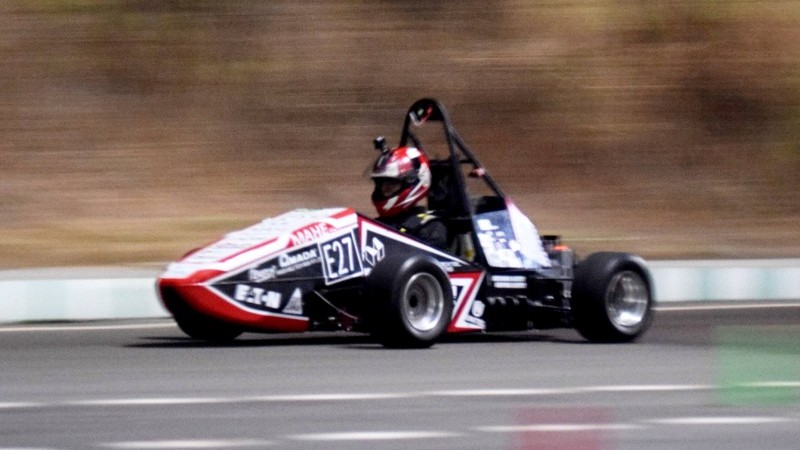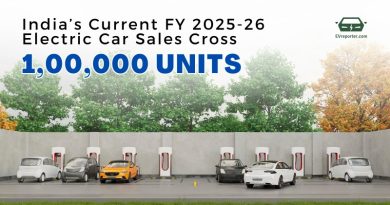Formula Manipal’s transition to electric mobility: A deep dive into India’s student-led EV engineering
Formula Manipal team recently got in touch with EVreporter and shared about their multi-dimensional work on EV engineering. This article showcases how a student team has been taking up advanced electric vehicle research and representing the country on various reputed forums globally.
From Combustion to Electric: A Strategic Shift
Formula Manipal, the Formula Student team from Manipal Institute of Technology, has been designing and building race cars since 2007. Over the years, the team has represented India in leading Formula Student competitions across Europe, including Italy, Austria, the Czech Republic, Hungary, and Germany, securing notable rankings such as 12th and 14th overall in 2023.
In line with the global transition toward sustainable mobility, the team initiated its shift from combustion engines to electric propulsion in 2024. Within ten months, the group developed its first all-electric prototype, integrating concept design, simulation, manufacturing, and testing.
FMXXV: The First All-Electric Formula Manipal Car

FMXXV, the 14th car in the series, represents a major milestone for Formula Manipal — the team’s Electric race car for Formula Bharat 2025 developed after transitioning entirely to electric power. Its design and validation were guided by four key evaluation pillars:
1. Performance: Acceleration, cornering, and handling precision.
2. Reliability: Endurance and repeatability under dynamic conditions.
3. Safety: Compliance with Formula Student safety standards and electrical regulations.
4. Serviceability: Ease of maintenance and modular subsystem integration.
This structured approach helped the team optimize efficiency and minimize development risks across all subsystems.
Structural Design and Chassis
The car’s chassis is made from AISI 4130 Chromoly steel, designed through Finite Element Analysis (FEA) to ensure rigidity, crash safety, and weight optimization.
- Material: AISI 4130 Chromoly.
- Manufacturing: TIG-welded tubular space frame.
- Validation: Through torsional analysis.
The result is a robust structure with enhanced stiffness and improved serviceability for race operations.
Powertrain and Motor Configuration
Formula Manipal adopted a single-motor rear-wheel-drive layout to balance performance, efficiency, and packaging simplicity. After extensive trade-off and simulation studies, a single high-performance motor configuration was chosen.
The system is powered by an EMRAX 208 HV LC axial-flux PMSM, selected for its compact design, high power density, and proven reliability. It delivers 80 kW peak power, 140 Nm peak torque, and 100 Nm continuous torque at a mass of only 14 kg — yielding a power-to-weight ratio of approximately 5.7 kW/kg.
- The motor is coupled with a Rinehart PM100DZ inverter (100 kW rated, 12 kg), ensuring efficient torque control and seamless power delivery across varying track conditions.
- Simulation-based validation using OptimumLap confirmed optimal performance for a 320 kg vehicle mass, enabling strong acceleration, stable handling, and competitive endurance efficiency.
- The system employs liquid cooling for consistent thermal performance and is managed by a custom logic controller ensuring robust communication, fault detection, and control reliability.
Key Specifications:
- Motor: EMRAX 208 HV LC (Axial Flux PMSM)
- Inverter: Rinehart PM100DZ
- Peak Power: 80 kW
- Peak Torque: 240 Nm
- Cooling: Liquid-cooled system
- Layout: Single-motor rear-wheel drive
Battery and Energy Storage
- The accumulator was engineered to deliver high energy density and thermal stability while complying with Formula Student’s strict safety and voltage limits. It is built using Molicel P42A cylindrical NMC cells in a 106s4p configuration, providing a total energy of 7.5 kWh at a nominal voltage of 380 V (max 600 V).
- The pack is divided into six segments (five of 18s4p and one of 16s4p) to meet the 120 VDC and 6 MJ per-stack rulebook constraints. Lightweight polycarbonate endplates (UL94 V0 rated) enhance structural rigidity and safety.
- SigmaClad 60 (Ni–Steel–Cu) was selected for busbars, offering optimal conductivity, weldability, and weight efficiency with an ampacity of 10.5 A/mm².
- A semi-custom BMS with master–slave architecture ensures continuous voltage, current, and temperature monitoring. Communication is handled via ISO-SPI and CAN, with integrated Insulation Monitoring Device (IMD) for fault detection and automatic shutdown in case of isolation failure.
- The thermal system employs forced-air cooling, using high-performance fans to maintain temperature rise within 2.6 °C per endurance lap—balancing reliability, weight, and simplicity.
Key Specifications:
- Battery Chemistry: Lithium-ion NMC (Molicel P42A)
- Configuration: 106s4p (7.5 kWh, 380 V nominal)
- Cooling: Forced-air convection
- Busbar Material: SigmaClad 60 (Ni–Steel–Cu composite)
- BMS: Master–slave architecture with ISO-SPI & CAN communication
- Safety Systems: Active cell balancing, IMD-based fault shutdown, temperature monitoring
Cooling and Aerodynamics
Cooling and weight balance were engineered as integrated performance systems rather than standalone subsystems. Using STAR-CCM+–based CFD simulations, the radiator and shroud geometry were optimized for airflow efficiency, achieving 0.8 kg/s mass flow with minimal drag penalty. A rear-mounted radiator configuration was selected for its superior aerodynamic performance and favorable weight distribution, validated through bench flow testing and wool tuft visualization. CAD-based packaging and kinematic studies helped achieve a 47.3% front weight bias and a low 258 mm center of gravity, enhancing stability in braking and cornering. The result is a thermally efficient, aerodynamically balanced car with predictable handling and improved dynamic response.
Vehicle Dynamics and Braking
Vehicle dynamics development began with optimizing tyre performance using Formula SAE Tyre Test Consortium data to achieve the ideal balance between grip, stability, and predictability. A transient vehicle model in ChassisSim guided lap-time sensitivity studies, while OptimumKinematics was used to refine suspension geometry for maximum contact patch stability. Camber, toe, and Ackermann parameters were tuned to ensure precise turn-in and balanced cornering behaviour. Packaging studies in Fusion 360 helped define weight distribution and center of gravity, validated through ANSYS load simulations for structural integrity. The braking system was engineered for maximum and consistent stopping performance, with rotors dimensioned to achieve simultaneous four-wheel lock. Their thermal capacity was verified using ANSYS CFD, confirming reliable operation under repeated high-energy stops without fade or structural compromise. This integrated approach ensured that FMXXV delivers predictable handling, strong braking, and endurance-ready performance on track.
Manufacturing, Validation, and Testing
Most subsystems—including the chassis, accumulator casing, and cooling ducts—were designed and manufactured entirely in-house, reflecting the team’s focus on self-reliant engineering and precision craftsmanship. Each component underwent a rigorous validation cycle involving low-speed shakedowns, endurance simulations, and detailed data acquisition to evaluate efficiency, structural integrity, and thermal performance. This hands-on approach not only ensured technical reliability but also strengthened the team’s understanding of how every subsystem contributes to the car’s performance on track.
Performance and Results
At Formula Bharat 2025, Formula Manipal achieved:

- 3rd position nationwide.
- 2nd place in Statics category.
- 3rd place In the Cost and Manufacturing event.
- Best Powertrain Design award.
- Successful completion of all electrical and mechanical inspections
The vehicle showed stable performance across acceleration, endurance, and efficiency events, validating the electric powertrain’s robustness and design approach.
Future Roadmap
The next chapter for Formula Manipal is already in motion — the development of the team’s first driverless electric race car. This evolution combines cutting-edge perception systems, control algorithms, and autonomous software with the team’s deep experience in electric powertrains. Alongside this, efforts are underway to refine battery packaging, weight optimization, and motor control efficiency for the next generation of competition vehicles. More than just a technical upgrade, this transition reflects Formula Manipal’s enduring spirit — where every season pushes boundaries, every car tells a new story, and every challenge is met with the same drive to innovate, learn, and lead India’s electric motorsport future.
Also read: Formula E- Electric Cars race on the city street circuits
Subscribe today for free and stay on top of latest developments in EV domain.






